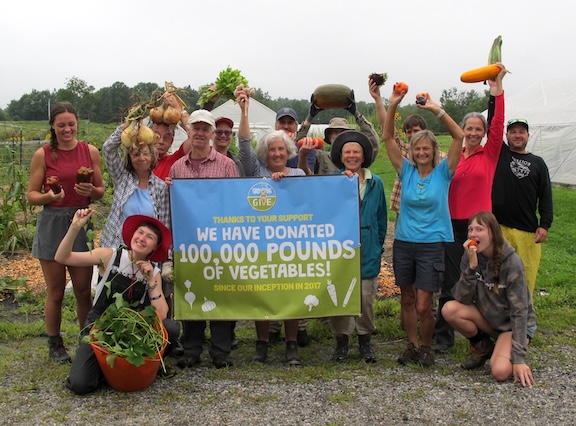By Martha Leggat, Growing to Give Education Coordinator
If you arrive at Growing to Give early enough on a summer morning, you’ll find a quiet moment to savor the brilliant purple amaranth, the 6-foot-tall sunflowers, and the dahlias of every color and variety. You’ll observe contrasting rows of companion-planted vegetables filling the garden beds and wood chips neatly covering the walking paths. The five resident goats might greet you. This period of silence won’t last for long.
At 8 a.m., the farm begins to buzz. As staff members arrive, they review the white board filled with a comprehensive list of the day’s projects. Soon after, gleaning teams descend, spreading out to harvest vegetables in plots carefully numbered for identification. Pounds of produce are picked, weighed, boxed, and moved to cars for transport. By mid-morning, the farm population peaks, as farm volunteers and “Fix-It” team members join the fray; some weed and apply compost to the gardens, while others repair a torn hoop house — according to their skills and interests. Adding to the energy might be a school group learning and observing in an experiential setting while tackling jobs with a speed that only youth are capable of. Volunteers aged 3 to 93 work in different capacities, enabling Growing to Give to grow and give a wealth of food, while simultaneously creating a vibrant, tight-knit community.

The Roots of Growing to Give
Located at Scatter Good Farm in Brunswick, Maine, Growing to Give incorporated as a nonprofit in 2017, growing organic vegetables using climate-friendly methods and donating them to local people struggling with food insecurity through food pantries and other access sites. In 2024, the farm surpassed 100,000 pounds of food donated over its eight-year history.
Patty Carton and John Newlin moved to what is now Scatter Good Farm in 2002, originally running it as a hobby farm while working other jobs and raising their children. The farm slowly evolved into a community farm, thanks to periodic neighborhood parties held several times a year around the change of seasons. With an increasing interest in climate change mitigation, in 2015 Newlin and Carton adopted no-till practices and began using carbon-sequestering biochar and electric farm equipment. The farm received organic certification through MOFGA a year later, and the farmers began collaborating with close friend Theda Lyden, who had a history as both an executive chef and organic market farmer.
The trio’s original vision was to grow vegetables to make an organic pizza sauce. On a beautiful October weekend in 2016, Lyden applied her cooking acumen to processing tomatoes, garlic, and herbs in the commercial kitchen at Newlin and Carton’s house. During the 10 hours Lyden spent chopping, peeling, and cooking, she started becoming a bit grumpy. It might have been too many hours in the kitchen. However, the feeling persisted the following day, and Lyden recognized it was not how one should feel when cooking for others; she should have been cooking with love. As the 20 gallons of sauce came up to temperature, Lyden began filling the jars. Unexplainably, one of the jars cracked as she was pouring in sauce, shattering glass into the pot, spilling boiling sauce all over herself, and ruining the product. The debacle led Lyden to think about why she had been so irritable, and she concluded that she didn’t want to be inside anymore. She had been cooking and baking in dark kitchens for years and wanted to work outside instead. But what would become of the remaining beautiful bushels of peppers and other produce? In consultation with Carton and Newlin, she reached out to a friend who worked for the Merrymeeting Gleaners. When Lyden shared that the vegetables needed a home, as the pizza sauce business was folding, her friend responded, “I know exactly where to take them!” At the pick-up, they suggested shifting from producing sauce to becoming a food bank farm. The three founders realized that this would combine their passion for growing food in a sustainable way, while helping to mitigate climate change and food insecurity. Growing to Give was born. (And Lyden has since shared that the moral of the tomato sauce story is: “If you don’t listen to the universe, it will step in and burn you!”)
The early years brought some organizational challenges typical of setting up a nonprofit, but Growing to Give connected with gleaning organizations to determine what vegetables the smaller, and often undersupplied, local food banks and pantries needed most. It developed plans with food access sites to streamline both harvesting and transporting the farm bounty. And the gardens produced, yielding two tons of food to donate in 2017, meeting the nonprofit’s goal. With the help of teams of volunteers, donations nearly quadrupled in 2018: Growing to Give grew close to eight tons of organic vegetables on a half-acre of land. This food was distributed to over 20 local food access sites in Midcoast Maine.

Becoming an Educational Resource
While the amount of food produced and donated has always been one measure of the success of Growing to Give, the nonprofit also functions in the community as an educational resource for people interested in climate-friendly farming practices. Elementary students to high school graduates take part in experiential learning activities including plant identification, soil sampling, weeding, and harvesting.
The farm is a community gathering place and a social hub where volunteers of all ages join in the satisfying act of working the earth and completing a shared project. The season kicks off when the ground is still frozen, with volunteers congregating to make hundreds of paper pots for spring seedlings. The seedling house is often packed with volunteers in early April, planting seeds and transplanting small seedlings. During the growing season, all work stops at noon to ensure that staff and volunteers enjoy each other beyond the fields — at the lunch table. Fridays are farm potlucks, when the meal’s theme might be a favorite childhood recipe, a dish that features a certain vegetable, or a prepared food of a certain color. Growing to Give’s Farmyard Jam opens the farm to community members for a summer evening of farm games, live music, food trucks, farm tours, and goat berry bingo. At a simpler level, volunteers of all ages recognize that working on shared projects — whether weeding, fixing, planting, or harvesting — provides unrivaled opportunities for conversation. Those conversations are often better than many we have in more distracted life circumstances.
A more formal kind of education offered at Growing to Give is through the Farm Skills Training Program. A collaboration with Merrymeeting Food Council, Goodwill Industries, and other partners, the program’s goal is to address Maine’s longstanding farm-labor shortage and support people who face economic challenges and/or barriers to employment. Trainees learn about small-scale farming and growing food independently, while developing confidence and networks that help them advance in their personal and professional lives. Currently in its fourth year, this initiative is another example of how Growing to Give builds community. During the 11-week paid training program, participants work and learn together, developing new skills in both the field and the kitchen in a no-judgement environment.
Continued Growth and Community Connection
2025 will be a year of transition at Growing to Give, as its lead farmer, cofounder Theda Lyden, is stepping away from farming operations. Her large shoes will be filled by Lindsay Wasko who brings experience as both a farmer and farm manager. While Wasko has great visions for the future of Growing to Give, she recognizes the importance of learning the systems and practices of this unique farm environment and getting to know the community members. She knows there are many people who lack access to healthy food and looks forward to working towards the goals of the founding members: growing vegetables in a sustainable way to feed those who wouldn’t otherwise have access. She is also looking forward to working with the unique network built through this common goal. Wasko says, “Never have I been so warmly welcomed into a community, from board members, to volunteers, to staff. I’m so excited to get started!” She isn’t alone in this appreciation. If one thing is guaranteed, Growing to Give will continue growing and giving into the future.
Martha Leggat works as Growing to Give’s education coordinator and also serves as a MOFGA board member.
This article originally appeared in the spring 2025 issue of The Maine Organic Farmer & Gardener.
